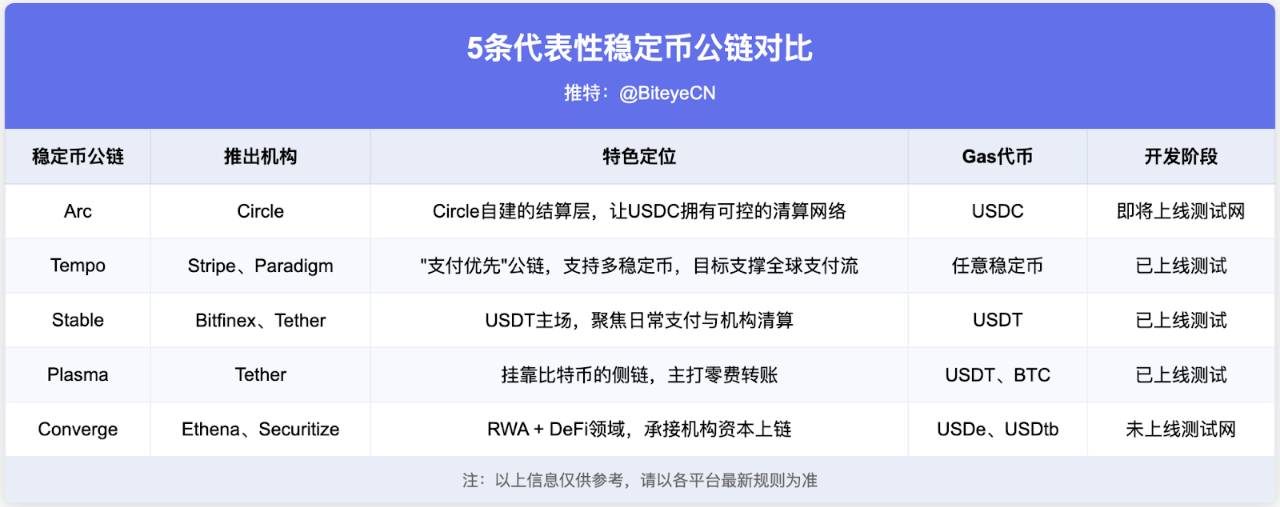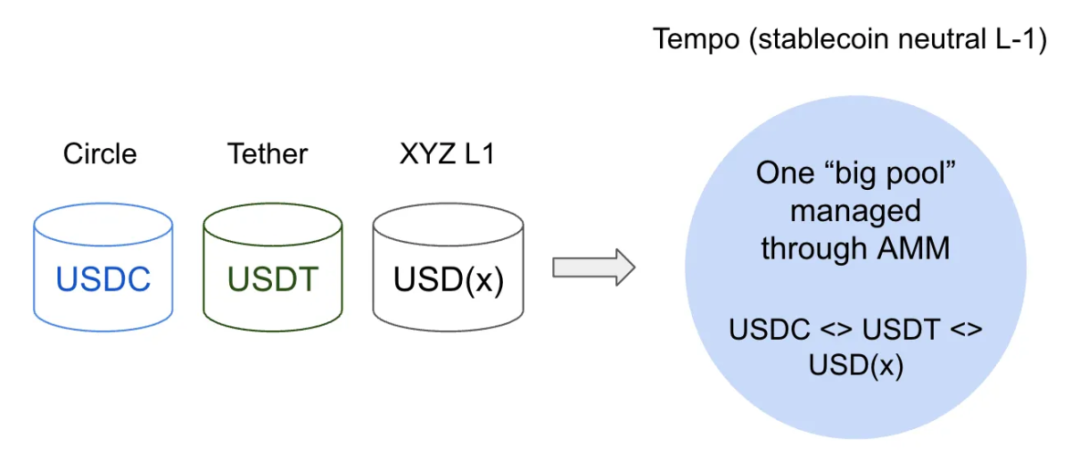Author: Biteye Core Contributor Viee
In the past few years, stablecoins have been the most "unassuming" protagonists in the crypto market, yet their scale has been continuously growing. Cross-border remittances, transaction settlements, compliance pilots… stablecoins have always been an indispensable gear in the flow of crypto capital.
This year, a more milestone change has occurred: stablecoin issuers are no longer satisfied with "standing on the chain," but are starting to build their own chains. In August, Circle announced the launch of Arc, followed closely by more details from Tempo, led by Stripe. Two giants that have been deeply involved in stablecoins took this step almost simultaneously, and the logic behind it is intriguing.
Why do stablecoins need their own chain? In this seemingly "B-end dominated" game, do retail investors still have a chance? When stablecoins control the "money route," do general public chains like Ethereum and Solana still hold enough influence?
This article will explore from four angles:
- What is a stablecoin public chain, and how does it differ from traditional public chains;
- A comparison of the design paths of representative projects;
- Will stablecoin public chains threaten Ethereum;
- Opportunities for ordinary users to get involved.
01 Stablecoin Public Chain: A Path Closer to the "Settlement Layer"
If Ethereum, Solana, and other public chains focus on decentralized applications, then stablecoin public chains are closer to the settlement layer.
They have several distinct characteristics:
- Stablecoins as Gas: Transaction fees are stable and predictable, eliminating the need to hold volatile assets to pay "tolls."
- Optimized for payments and settlements: The goal is not "universal," but rather "stable and user-friendly."
- Built-in compliance modules: Facilitates connections with banks and payment institutions, reducing gray areas.
- Designed around the demand for "money": Cross-currency settlements, foreign exchange matching, unified accounting units, more closely aligned with real-world settlement systems.
In other words, stablecoin public chains resemble a vertically integrated model, controlling key links from issuance, settlement to application as much as possible. The cost is the pressure of cold start in the early stages, but in the long run, it can achieve economies of scale and influence.
02 Different Paths Taken by 5 Representative Chains

1. Arc @arc: Circle's First Proprietary Public Chain
As the second-largest stablecoin issuer globally, Circle's launch of Arc is not surprising. Although the market size of USDC is enormous, transaction fees are subject to the volatility of Ethereum or other public chains. The emergence of Arc is precisely Circle's attempt to build its own "settlement layer."
Arc's design has three core points:
- USDC as Gas: Transparent transaction fees with no exchange rate risk.
- Fast transactions, stable settlements: Promises to confirm transactions within 1 second, suitable for cross-border payments and large settlements.
- Optional privacy features: Provides necessary accounting privacy for enterprises or institutions while ensuring compliance.
This means that Arc is not only a technical attempt by Circle but also a crucial step towards becoming a financial infrastructure provider.
2. Tempo @tempo: "Payment-First" Public Chain
Tempo is co-incubated by Stripe and Paradigm, with a straightforward core logic: after stablecoins become mainstream, a truly suitable infrastructure for payments is needed. Traditional public chains either have unstable fees, insufficient performance, or overly "crypto-native" experiences, making it difficult to support global settlement flows. Tempo aims to fill this gap.
Therefore, Tempo's design features several distinct characteristics:
- Any stablecoin can serve as Gas: Achieves stablecoin swaps through built-in AMM.
- Low fees & predictability: Equipped with payment channels, notes, and whitelist features, closer to real-world payment systems.
- Extreme performance: Aims for 100,000 TPS with sub-second confirmations, suitable for payroll, remittances, micro-payments, and other scenarios.
- EVM compatible: Based on Reth architecture, low migration costs for developers.
Its partners are also quite substantial, including Visa, Deutsche Bank, Shopify, OpenAI… This makes Tempo more like an open dollar payment network rather than an attachment to a single stablecoin. If successfully implemented, it could even become a prototype for an "on-chain payroll system."
Although Tempo emphasizes "payment-first," its level of decentralization has sparked some discussions. Currently, Tempo's design leans more towards the attributes of a "consortium chain" rather than a "public chain," with nodes not being completely open, resulting in a somewhat weaker degree of decentralization.

3. Stable @stable: The Home Ground of USDT
Stable is a payment chain specifically built for USDT, supported by Bitfinex and USDT0, aiming to facilitate smoother circulation of USDT in daily financial activities.
In its design, Stable has accomplished several things:
- USDT as native Gas: Transaction fees are paid directly in USDT, with peer-to-peer transfers completely fee-free.
- Second-level confirmations: Balances small payments and large fund flows.
- Enterprise-level features: Including batch transfer aggregation and compliant privacy transfers.
- Consumer-side experience: Wallet integration with bank cards and merchant payments.
- Developer-friendly: EVM compatible and provides a complete SDK.
The keyword for Stable is implementation, focusing on how to integrate USDT more naturally into daily scenarios such as cross-border remittances, merchant payments, and institutional settlements.
4. Plasma @PlasmaFDN: Bitcoin Sidechain
Unlike Stable, Plasma has chosen a different path. As a sidechain of Bitcoin, it relies on BTC's security while focusing on stablecoin payments.
In its design, Plasma mainly has the following features:
- Bitcoin native bridge: BTC can cross-chain into the EVM environment without custody, directly participating in the stablecoin ecosystem.
- Zero-fee USDT transfers: Completing USDT transfers for free is its biggest selling point.
- Customizable Gas tokens: Developers can choose stablecoins or ecosystem tokens for payment.
- Optional privacy features: Suitable for payroll distribution and institutional settlements.
- EVM compatible: Based on Reth architecture, low migration costs for developers.
In July, Plasma officially launched its public sale, with a token of $XPL, ultimately raising over $373 million, with oversubscription exceeding 7 times. The market enthusiasm has already given it a strong boost.
5. Converge @convergeonchain: The Convergence of RWA and DeFi
The previous chains essentially revolve around "stablecoin settlement payments." Converge's ambition is different; its goal is to bring RWA and DeFi onto the same chain.
In terms of design logic, Converge focuses on three key points:
- High performance: Block times in the hundreds of milliseconds, pushing performance limits in collaboration with Arbitrum and Celestia.
- Stablecoin native Gas: USDe and USDtb are used as transaction fees.
- Institutional-level security: Provides additional protection relying on the ENA network (CVN).
In summary, Converge aims to solve the problem of "how to safely and efficiently bring in large funds." Its partners include familiar DeFi protocols like Aave, Pendle, and Morpho, and it will also support the integration of RWA assets like Securitize.
03 Different Starting Points, Common Direction
From Arc to Tempo, from Stable, Plasma to Converge, although the approaches differ, they attempt to solve a core issue: how stablecoins can truly enter the daily financial cycle. Arc and Stable focus on the controllability of their own assets, Tempo and Plasma emphasize multi-currency neutrality, while Converge directly targets institutions and RWA. The difference lies in the path, but the common goal is to make transfers more certain, liquidity smoother, and compliance more natural.
Following this main line, the future of stablecoin public chains can generally be seen in three trends:
- Compliance and institutionalization: Stablecoin public chains will focus more on settlement certainty and compliance interfaces in the future, with Arc, Stable, and others striving to become settlement layers that banks and payment institutions can directly connect to.
- Challenges to traditional payments: Chains designed with "multi-currency neutrality" like Tempo pose alternative pressure on Visa and Mastercard due to their low costs and global reach.
- Reshaping the market landscape: Currently, Circle and Tether hold nearly 90% of the stablecoin market share, creating a near-duopoly, but "stablecoin-neutral chains" like Tempo are breaking this pattern, potentially leading to a multipolar coexistence in the future.
04 How Will Stablecoin Chain Creation Rewrite the Public Chain Landscape?
The most direct question regarding stablecoin issuers creating chains is whether they will impact general public chains like Ethereum and Solana.
Stablecoin chains are inherently born for "money routes," making them indeed more suitable for high-frequency but low-risk businesses like cross-border remittances and payroll than the ETH mainnet or Solana. The impact on TRON could be more direct. TRON's stablecoins mainly come from USDT, accounting for over 99%, and it has already become the largest issuing public chain for USDT. However, if the Stable chain promoted by Tether gradually matures, TRON's biggest competitive advantage will be weakened.
However, some argue that these "payment-specific chains" do not truly qualify as blockchains in the real sense. Because if complete decentralization is achieved, it cannot avoid the influx of various unrelated projects and tokens, resulting in congestion and performance degradation; but if it chooses to only serve payments, it will either be functionally minimal like Bitcoin, only capable of transfers, or partially centralized, with a small number of institutions controlling the nodes. In other words, it is challenging to balance both "decentralization" and "payment efficiency."
This also means that the positioning of Ethereum and Solana is actually quite secure. The former has built a developer ecosystem based on security and composable general finance, while the latter has carved out its own niche in high performance and user experience. Ultimately, the competitive landscape is more likely to see stablecoin chains handling certain settlements, while ETH/SOL retains open innovation.
05 Retail Investor Perspective: Where Are the Opportunities?
Frankly speaking, this round of opportunities is not friendly to retail investors in terms of "direct benefits." Compared to past public chains, stablecoin public chains lean more towards the "B-end," involving payment, settlement, and custody systems.
However, there are still several entry points worth paying attention to:
- Participation in ecological incentives: New chains often come with bounty programs, developer subsidies, and transaction mining during their cold start, and similar activities may be promoted in the future.
- Node staking: More technically skilled players can focus on node validation. For example, Converge requires staking ENA to participate.
- Testnets: Many projects will airdrop rewards to early users, so it’s advisable to pay attention to testnets. For instance, ARC may launch a public testnet this fall, while Stable, Plasma, and Tempo testnets are already online.
- Long-term allocation: If you are optimistic about the "stablecoin public chain" narrative, consider longer-term investments, such as focusing on related stocks like Circle and Coinbase.
It is particularly worth mentioning Plasma. In July, it conducted a public sale where the token $XPL was oversubscribed by 7 times, with a total amount exceeding $370 million. It subsequently partnered with Binance for an airdrop event, which was fully claimed within an hour. Even in a relatively "institutionalized" track, early retail investors still have the opportunity to reap benefits.
06 Conclusion
Stablecoin public chains will not disrupt the crypto market overnight. Their changes occur more in the background, such as shorter settlement paths, more stable transaction fees, and smoother regulatory interfaces.
On the surface, these narratives may seem to lack "sexiness," but at the infrastructure level, they are gradually building the "water, electricity, and gas" for stablecoins. When we shift our perspective from "price" to "how money flows," the logic becomes clearer:
- Who can guarantee the certainty of settlements;
- Who can provide stable cross-currency liquidity;
- Who can connect real payment scenarios.
Stablecoin public chains are likely to be the most solid narrative in the next bull market. If projects can truly deliver on these three aspects, it will not just be a "public chain," but may become the infrastructure for the next generation of crypto finance.
免责声明:本文章仅代表作者个人观点,不代表本平台的立场和观点。本文章仅供信息分享,不构成对任何人的任何投资建议。用户与作者之间的任何争议,与本平台无关。如网页中刊载的文章或图片涉及侵权,请提供相关的权利证明和身份证明发送邮件到support@aicoin.com,本平台相关工作人员将会进行核查。




